|
|
|
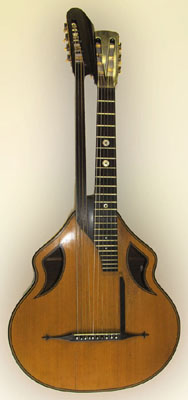
|
The wappen (shield)-shaped
instrument is in remarkable condition for one believed to have been
built in 1877 and eventually played for five decades by Perott.
In fact, it looks little different now from how it appears in
this 1905 photo of a dashing young Perott in Russia (courtesy again of the Gorelik family). We can
note a couple obvious features: It was originally built for Russian
guitar tuning, that is, 7 strings on the neck (tuned to an open G
chord), and 4 floating basses (typically C-E-F-A, to fill in the notes
around the neck’s low D & G [7th & 6th]
strings).
|
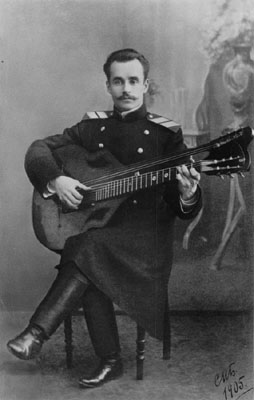
|
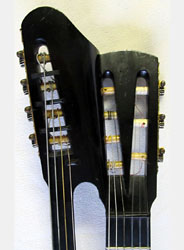 |
|
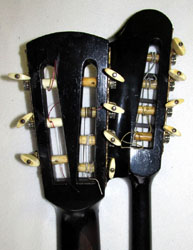 |
|
However, it is known that Perott preferred to concentrate solely on
standard 6-string neck tuning, and in every photo, including the 1905
image, we see that he strung his Russian-built harp guitar with only six strings on the neck. Curiously,
the current bridge only has pins for 10 strings, not 11, as it should
have had when built (to match the original 4 + 7 tuners and stringing).
Too bad Perott is covering up the bridge in the 1905 photo!
After some time, Peter Gorelik was able to inspect and
get decent photos of the underside of the bridge...and found that it
appears to be all original and with only ten string holes (below). I brainstormed this conundrum with kontragitarre aficionado
Benoît Meulle-Stef, and we came up with a couple possible
scenarios. The simplest answer would be that this was originally a
4 + 6, 10-string instrument, and that someone changed the neck before
Perott acquired it (he bought it a couple decades after it was
built). Perhaps the original broke and was replaced with something
convenient – in this case, a 7-string neck. A less convincing
scenario is one in which the maker intended on building a 10-string
instrument (I show one below, by the same maker), but ran out of
tuners. In other words, he didn't have the matching 3-plate for
the main neck's bass side. Seems unlikely? Well, consider
that the tuners used are still not correct. Ben noticed
that the 4-on-a-plate tuners used for the neck's low strings do not
follow standard Russian 7-string guitar practice. Every other
(typical) Russian 7-string utilizes a tuner set wherein the outer
rollers (top and bottom) of each side are in line, as
in this example. The half-set on Perott's harp guitar instead looks
like the same set used for the bass neck's 4 subs.
It seems we are left with a mystery, no matter
what! Ben also noted that the headstock originally had an ornament
(Cyrillic script?) affixed (in the 1905 photo). Today, we
can see small nail holes and an outline (roughly figure 8-shaped) from
where this was removed.
|
|
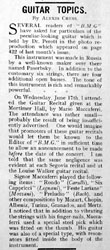
|
The "shield" body shape was not remotely unusual at this time
– neither in Leipzig nor its “sister city” St. Petersburg, where
this one was built – but might certainly have appeared strange to the
guitarists of London in the 1930s! This
is where Perott settled, and where he co-founded the PSG in 1929.
Proof of the unfamiliarity with such an instrument (or perhaps
any harp guitar, for that matter) in London is seen in that country’s
BMG (Banjo, Mandolin and Guitar) Magazine in the July, 1931 issue, where
Alexis Chess (A. Chesnakov, a co-founder of the PSG) answers curious
readers about Perott’s “peculiar-looking guitar.” NOTE
1
The 1931 article at left (kindly shared by Jan de
Kloe) finally identified the maker of Perott’s instrument as Paserbsky
(Frantz S.).
Jan at first told the owner that he thought it was around 120
years old (or c. 1890).
In the Stuart Button book, the guitar is identified
slightly differently: “This guitar was made in 1860 by Franz
Passierbski, a violin, guitar and balalaika maker of St. Petersburg. It
was originally obtained for Perott by his teacher, Vassilj Lebedev
(1867-1907). The instrument is unique and still survives today.” |
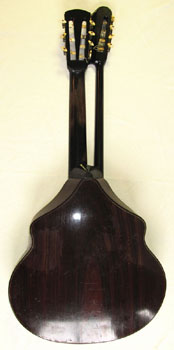
|
| I have no idea where Button got the information, but de
Kloe finally learned the true date, which he reveals in his book as 1877
(from personal correspondence between Perott and Gorelik). If
true, that makes it (as of this writing) 136 years old!
It was thus bought secondhand by Perott, with his teacher, Lebedev
(another Russian harp guitar player, in our encyclopedia here),
likely recommending or obtaining it for his student. |
|
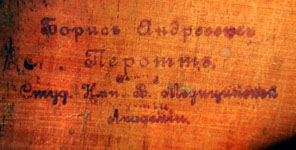
|
Jan further translated the existing inscription: “The
text on the guitar mentions that Perott is a stud(ent of) Nar. V.
Meditzinskiy Academy. ‘Nar’
stands for ‘narodny’ meaning ‘national’, ‘V’ stands for
Voyenno meaning Military. Perott was a student at the Military Medical
Institute where he studied to be a doctor (from 1902-1908). This academy
still exists today.”
About
a year ago, both Jan de Kloe and Oleg Timofeyev were able to
visit Stephen Gorelik and the Paserbsky. Jan (pictured) says that
Oleg (a true harp guitar player) "managed
very well, thanks probably to his exposure with comparable instruments."
|
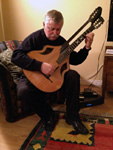
|
|
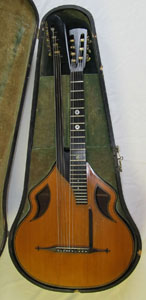
|
Another interesting feature is what I call the “pinky rail.” Perott
was of the “older” classical guitar tradition that played with the
little finger resting on the soundboard (this was one of the criticisms
that would be brought against him by Bream supporters), so I immediately
realized that this was a handy finger rest installed to allow the hand
to easily move from playing near the fingerboard to near the bridge
(compare this to the shorter
finger rest that Coste installed
on his instruments).
I was originally of the opinion that this must have been added by
Perott after obtaining his secondhand instrument, as I’d never seen
another specimen or catalog image with this feature.
But then someone sent me an image of another Russian harp
guitar with the same exact pinky rail, and I’ve since seen others,
including a second Paserbsky in the collection of Ivan Bariev (at
right). Note on this one the "cut-out" of the finger
rail to match the soundhole. This original Paserbsky has 3
sub-basses and 6 strings on the neck (both 6 and 7 string necks were
simultaneously offered in St. Petersburg, and even in some German
catalogs). |
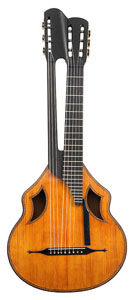
|
| It seems that this was apparently a somewhat more common
option than I had initially thought! (de Kloe’s book mentions “the
typical little bar…”; I’ve found this feature occurring on perhaps
ten percent of the several dozen Russian guitars I’ve now seen).
Interestingly, Perott’s teacher, Lebedev (who also played on
6-string necks) has the rail on each of his two known harp guitars
(at right). NOTE 2
|
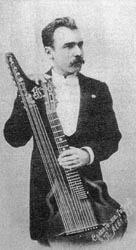 |
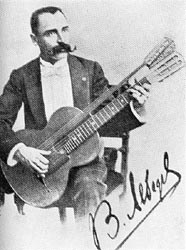 |
|
|
I hinted at the start that this very instrument
instigated some controversy in the world of London’s guitar society
– and Button’s book goes into this in detail, one of the most
telling records we have concerning the periodic “war” between harp
guitars and “normal” guitars. Perott
has been described by more than one fellow guitarist (somewhat
disparagingly) as “old school.” Not
unpredictably then, he also advocated extra bass strings, although it is
not clear if he actually tried to push this agenda among his students or
Society members (I sense not). NOTE
3
No, it was actually Henry
Bream – Julian’s father and amateur plectrum guitarist – who
became defender of the harp guitar, though unfortunately in a rather
inexperienced and heavy-handed fashion.
Naïve and embarrassing, in fact, when one reads his many letters
to Wlifred Appleby, then the Society’s Journal editor - and vehement
despiser of extra strings (detailed in Button’s book).
After a chance encounter with this very harp guitar
at the home of Dr. Perott, Henry Bream fell in love with its tone and
possibilities. He first
divided the membership of the PSG by surprising the group with his
finished letterhead for the Journal, which prominently featured the
distinctive harp guitar in the center.
About half the group was seriously ticked off, as they didn’t
think it represented their forward-thinking serious “classical guitar”
efforts. |
|
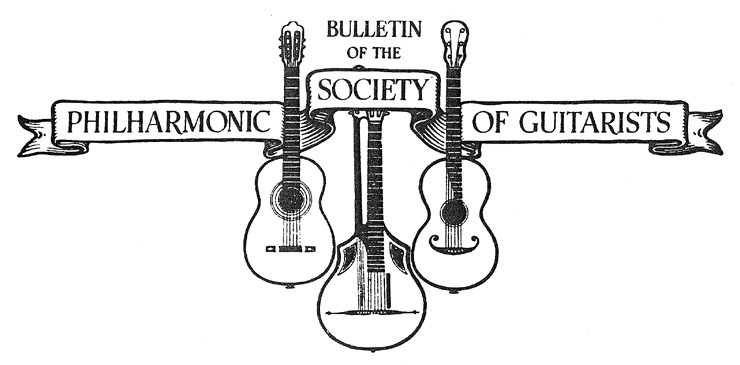
|
| Then things got really ugly
when Henry bought his young prodigy son – horrors – a Maccaferri harp
guitar! Young Bream
actually used this for one of his early debuts, though didn’t use any
of the sub-basses. Appleby
– and many of the other members – thought it a “monstrosity.”
My take away from the narrative is that Perott didn’t seem to
care one way or the other if Julian played the Maccaferri – after all,
to him this was normal – and probably wouldn’t have pressed the matter.
But he still wasn’t fairing much better politically, as the
supporters of the prodigy Julian – which now included everyone –
debated over whether he should be resting his little finger on the
soundboard like his old-fashioned teacher Perott. |
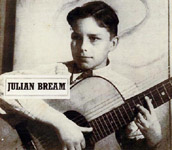
|
|
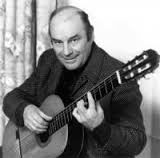
|
Though every single reference to Perott I find seems to prioritize his
celebrity as “Julian Bream’s first teacher,” Bream himself would
say many years later: “I had lessons with him after a little while,
for a year. He was an interesting man. He was quite old. He couldn’t
play anymore. But he was once in his youth quite a good guitarist. But
he played in the old Italian school, which is quite contrary to what the
modern Tarrega would be. And I found that the particular right hand
technique (i.e. resting the little finger – GM) wasn’t very useful for me.
Particularly for playing more Spanish and modern pieces. So after a
year, I discontinued and from then on, I was virtually learning on my
own.” |
|
|
Not to continue to dish on Perott, but I also seem
to find contrary views on the importance and place of the PSG among
those involved in the story of the classical guitar.
Button calls it a “society without direction, an obscure
movement, shrouded in mystery.” He
then quotes A. P. Sharpe, editor of the popular music BMG journal, who
wrote in his own magazine, “Many readers of BMG must have often
wondered just what the Philharmonic Society of Guitarists is and did.”
And Button, again: “Sharpe’s comment reflected the PSG’s
indolence, a society that promised so much yet accomplished so little…” Ouch. NOTE
4
Well, they tried.
And a few even tried to retain and include the “forgotten”
harp guitar as a legitimate classical instrument within their noble
society. Perott clearly wasn’t
shy or embarrassed about it.
I’m thrilled that his original Russian wappen-shaped harp
guitar made such waves in England and still survives after 136 years –
playable, yet! – as testament to Perott’s own strong-willed legacy.
Gorelik family: I hope you treasure and preserve your heirloom instrument.
And Mr. Bream:
ya could’a been a harp guitarist! |
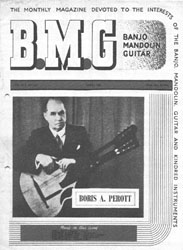
From Boris Perott – A Life with
the Guitar
(Chanterelle, 2012)
|
|
|
NOTE 1: In
the same column, it’s interesting to see how Chesnakov describes
attending a London Maccaferri concert, listing the program, Maccaferri’s
steel thumbpick, and the guitar’s internal resonator…sadly, no
mention is made of extra strings, and it’s possible
– since this is mid-1931 – that Maccaferri was perhaps playing one
of his new Selmer prototype 6-strings.
NOTE
2: As for the left image of
Lebedev - it is
very rare to see a virtuoso guitar soloist of the Viennese or
Russian schools with 9 sub-basses; typically 2-4, occasionally 5,
would be it. Interestingly, the instrument on the right
apparently survives, owned by Matanya Ophee. On
the photos, one can just make out what appear to be repairs to the
soundboard that would presumably match where the little finger rail was
originally attached (Richard Brune or Gary Southwell could surely
confirm this).
NOTE
3: I remain mystified by
the fact that the BMG editor would publicly insult the PSG, even as
Perott was in the midst of his extensive decade-long series on “famous
guitarists” for the BMG (much of De Kloe’s valuable biography
consists of correcting Perott’s many errors in these articles). Button
makes his views clear, de Kloe is more kind.
NOTE
4: In his book, Jan de Kloe entirely avoids the subject of floating
strings, though we’re treated to a few (and only a few) from Perott,
himself. In his 64-article
BMG “Famous Guitarist” series, Perott manages to slip in here and
there references to players who used guitars with floating strings (harp
guitars). He wisely refrains
from soapboxing, but is not afraid to say things like: “Other great
virtuosi of the guitar, including…(names 11 total)…proved, without a
shadow of a doubt, that the additional strings facilitate technique and
improve the tone of the instrument considerably.”
And elsewhere, “Practically all Russian, and many German,
virtuosi used instruments strung with the additional strings.” And,
again: “But there is no doubt that additional strings augment the
volume of tone and richness of the chords.” Curiously, while
mentioning Schenck’s and then Mozzani’s hollow-arm harp guitars,
Perott first maintains that they were unsuccessful due to their size,
“which necessitated a new technique which players were loth (sic)
to acquire.” He continues
with the opinion that, with microphones available (apparently, Perott
was a fan of miking the classical guitar), there was no reason for
Mozzani’s experiments, implying that his old Paserbsky was better. But
in a subsequent article just three months later, he praises Maccaferri’s
similar guitars, “especially one with a double neck” – perhaps
specifically due to the resonators, or perhaps because Maccaferri was a
friend?
|
|